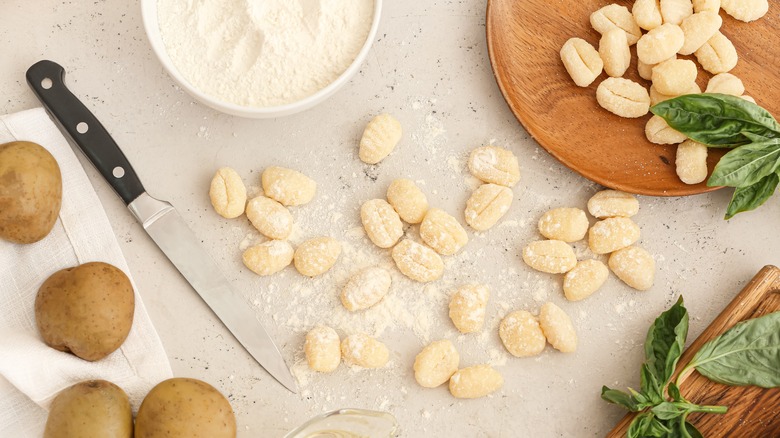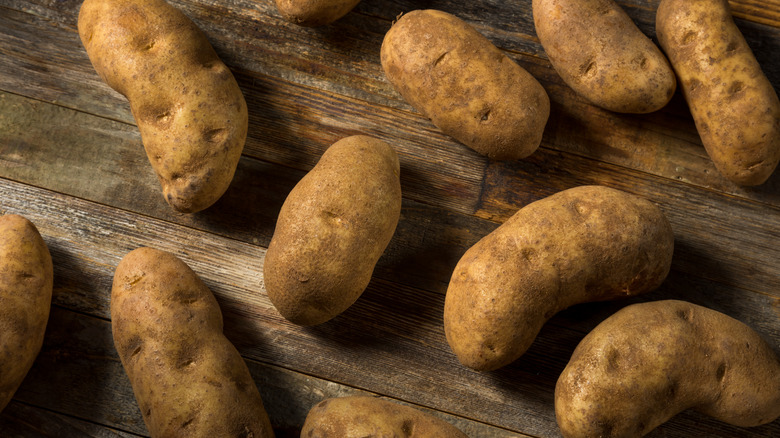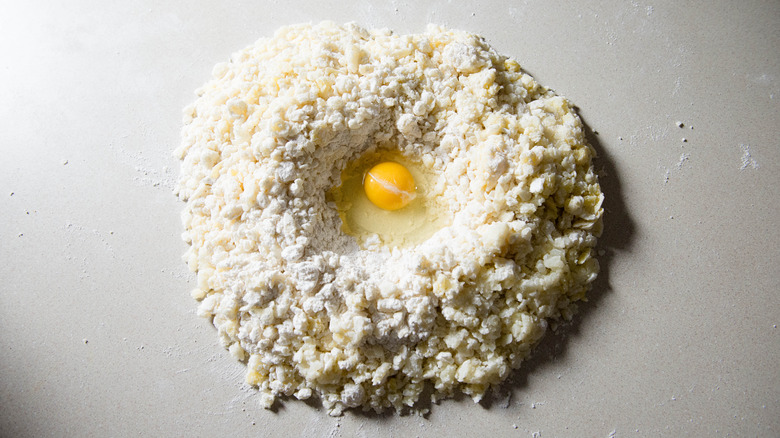The Absolute Best Potatoes To Use For Gnocchi
When gnocchi are made well, these potato-based dumplings are as light as air and pillowy-soft. When made poorly, however, they are dense and heavy, or sticky and doughy. These sad situations may result from using the wrong potatoes. Yes, there are right and wrong potatoes for making this Italian classic, and since gnocchi are notoriously finicky to make, you don't want to doom yourself from the start by choosing the wrong tuber for the job.
Excess moisture is a big detriment to gnocchi dough. Potatoes with a high water content can turn the dough mushy, and if you don't want that, you'll have to add a lot of flour to soak up the moisture, making the dumplings dense. It's a lose-lose situation, so you'll want to instead pick types of potatoes with very low moisture. It is best to select varieties with as much starch as possible, and these spuds are often called floury, mealy, or baking potatoes.
Russets are the most accessible high-starch spud available at a standard supermarket, but King Edward, Desiree, Linzer, Maris Piper, Early Puritan, Rosamunda, Evergood, Melody, and Porvita are also floury potatoes that will work well for gnocchi. Some recipes also call for medium-starch Yukon Gold potatoes. No matter what, avoid low-starch or "waxy" varieties as well as young or new potatoes, as they tend to be more watery.
How to prepare potatoes for gnocchi dough
When buying potatoes for gnocchi, look for spuds that are free of cuts, soft spots, or greenish coloring. Pick potatoes that are as close to the same size as possible. You have to cook them whole, so you want to make sure they cook at mostly the same rate. Do not be tempted to cut them, because smaller pieces will absorb water when boiled and lose their precious starches, resulting in dense gnocchi or ones that won't hold together well.
To prepare the spuds for gnocchi, scrub the potatoes clean (but do not peel them), place them in a pot, cover with salted water, and bring to a boil. Reduce the heat and simmer until tender. Alternatively, you can roast whole, pierced potatoes in the oven, which adds less moisture. Drain the potatoes well, if you've boiled them, and allow them to sit until cool enough to handle. Not only will you avoid burning yourself, but some excess water will evaporate from the spuds as they sit.
Finally, ricing potatoes creates a uniform and airy texture that allows for even more moisture to escape, contributing to a light dough. In a pinch, you can use a food mill or standard potato masher to mash the spuds to a fine puree, but you run the risk of making denser gnocchi. Work quickly and have your other tools and ingredients ready to go, since you must form the dough while the potatoes are still warm.
Choose the right flour for gnocchi, too
Gnocchi dough often only includes flour, potatoes, and salt, and sometimes egg yolks. Because it is such a simple dough, the type of flour and how much you use is extremely important. Italian flour referred to as 00 tenero or tipo 00 is often the product of choice for gnocchi connoisseurs. Though many sources say it is the low protein content that makes this flour worth seeking it, this is actually a common myth. It's actually the very fine grind that makes this flour yield super tender dumplings. If you cannot get your hands on this kind of Italian flour, you can use just all-purpose, or a mix of two parts all-purpose and one part cake flour for a more tender result.
Some recipes for gnocchi call for as little as four to five ounces of flour per pound of potatoes, but preparations that include eggs tend to have more. Gnocchi made without eggs are more delicate and light once cooked, but the dough can be harder to work with. Either way, work the dough as little as possible to keep the final dumplings light and airy. Figuring out how to make the perfect gnocchi may take a little trial and error, as everyone's kitchens and ingredients can be different, but starting with a starchier potato is a great way to set yourself up for success.



